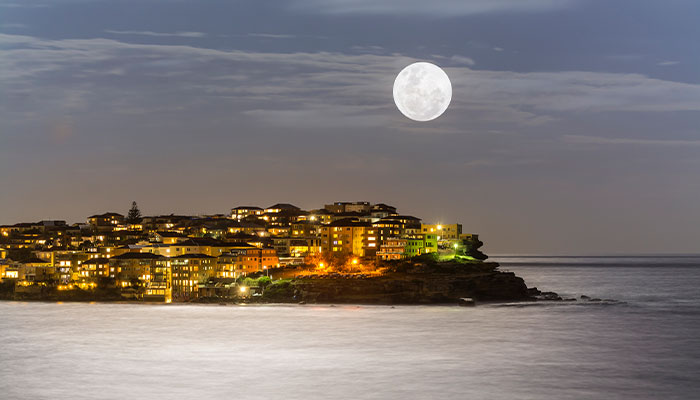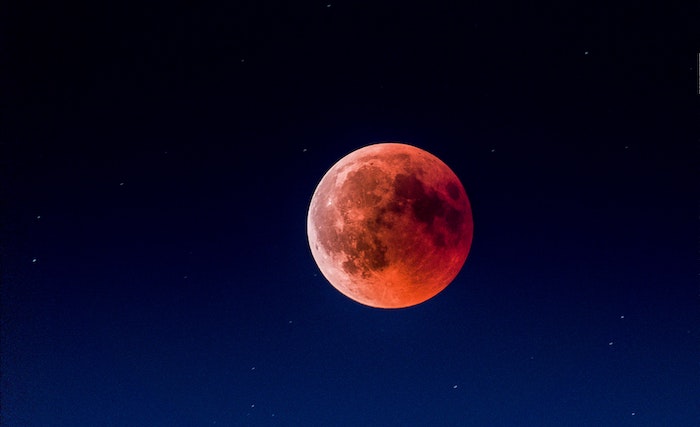While millions of visitors enjoyed the stunning light displays at Sydney’s Vivid festival, there are plenty of spectacular light shows in the night sky for those who care to look, says Macquarie University astronomer Professor Orsola De Marco.

Bigger, closer: A supermoon over Bondi … keep your eyes peeled on July 15 and August 11
Supermoons
July 15 and August 11
A supermoon is one of the best-recognised astronomy events, because it is bright enough to be seen among light-infused city skies, with the ‘strawberry moon’ on June 14 even standing out during the light displays of the Vivid festival.
Don’t expect a pink-hued moon though; the full moon in June is so-named by Algonquin Native American people for its appearance when wild strawberries start to ripen.
“The moon does not orbit around the earth in a perfect circle but it traces an ellipse, so the closest part of the orbit, the apogee, and the furthest, or perigee, happen once a month,” says Professor Orsola De Marco, Director of Macquarie University’s Astronomy, Astrophysics and Astrophotonics Research Centre.
“When the time of closest approach corresponds with a full moon, we get a supermoon,” she says.
Supermoons happen a few times a year when the moon’s orbit brings it just over 10 per cent closer to Earth than it is at its farthest, so the moon can appear noticeably bigger and, being closer, it can also drive higher-than-usual tides.
Lunar eclipse
November 8, 9.15pm to 10.45 pm
Another spectacular moon-focused event will be the total lunar eclipse that can be viewed from Sydney on the night of November 8, between about 9pm and 11pm.

Blocked from the sun: The surface of the moon can appear to turn red during a lunar eclipse.
“The lunar eclipse is the opposite of a solar eclipse, because it involves the Earth casting its shadow onto the moon, and by comparison the earth casts a very large shadow,” explains De Marco.
“The orbits line up so that, from this tiny area on the planet that we are viewing from, we can see that the Sun is behind the Earth, the Earth is in the middle and it is blocking the Sun’s light from reaching the lunar surface,” she says.
When there’s a clear night sky, a total lunar eclipse can be stunning, as the red light scattered by Earth’s atmosphere towards the moon means that the surface of the moon appears to turn red.
Meteor showers
Perseid – August 11-13
Fingers crossed that we’ll get a break from La Nina rain clouds in coming months and clear skies in Sydney to watch the dazzling Perseid meteor shower rain down shooting stars.

Bright sparks: Meteors are tiny fragments that burn up in Earth’s atmosphere, Professor De Marco explains.
Meteor showers are among the most reliable and enjoyable events for amateur astronomers, says De Marco, because even when conditions aren’t ideal, there’s a lot to see.
The Perseid meteor shower happens each August as Earth passes through the trail of debris shed by the Swift-Tuttle comet, an icy ball of rocks and gas 26 kilometres wide made up of remnants of the formation of our solar system, which last crossed Earth’s orbit in 1992, and returns every 133 years.
“The meteors are tiny fragments, mostly smaller than a grain of rice, that burn up in the atmosphere of Earth,” says De Marco.
The Gemind shower is one of the few that doesn’t involve a comet – instead, this debris trail comes from the near-earth asteroid.
The bright sparks of a meteor shower disappear too quickly for most telescope users, but the peak of the shower for Sydney viewers – where there may be up to a hundred shooting stars in an hour – will occur around 3am on August 13.
Unfortunately Perseid coincides with a full moon during 2022, making meteors less visible.
While the Perseid shower is one of the best-known, brightest and most spectacular, there are a few other meteor showers coming up that are worth watching, De Marco says.
Piscis Austrinids, Alpha Capricornids, and Southern Delta Aquariids – July 28-30
July 28-30 will see the peak of three meteor showers – Piscis Austrinids, Alpha Capricornids, and Southern Delta Aquariids, all coming from the same area of the night sky.
Alpha Capricornids – from the comet 169P-NEAT (which split from a different comet around 3000 years ago) – can produce very bright ‘fireball’ meteors that appear to fall slowly across the sky.
The three showers will peak during the dark sky of a new moon, and between them may produce around 35 meteors per hour at their peak.
The Orionids – October 25
Earth intersects with the trail of the famous Halley’s comet in May and October each year, and while the second pass-through – the Orionid shower – produces less meteors (around 20 per hour at their peak), these can be very fast and bright.
This year the Orionid shower peak coincides with the dark sky of a new moon, so it may offer some great viewing if the night is clear.
The Geminids – December 14
The Gemind shower is one of the few that doesn’t involve a comet – instead, this debris trail comes from the near-earth asteroid 3200 Phaethon, which ranges between the orbits of Mercury and the Asteroid Belt, trailing dust and rock fragments across Earth’s orbit each December.
The peak of the shower of up to 150 meteors each hour, will occur around 11pm but may be outshone by a waning gibbous moon.

(pictured) is Professor in the School of Mathematical and Physical Sciences






